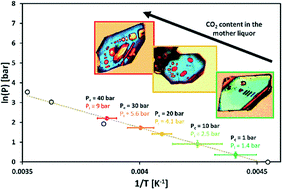Evidence of two types of fluid inclusions in single crystals†
Abstract
Investigations about the physico-chemical behaviour of fluid inclusions by means of thermal treatments and slow crystal dissolution lead to the evidence of two different kinds of gas bubbles. The results are reproducible for several organic and inorganic crystals obtained in aqueous solutions or organic solvents. Experiments under various pressures highlighted that the solubility of dissolved gases can play a significant role in the number of formed vacuoles. In addition, the nature of the dissolved gas in the mother liquor had an influence on the type of trapped bubbles. Raman spectroscopy confirmed that gaseous bubbles in fluid inclusions were rich in the gas that was dissolved in the mother liquor. Moreover, the pressure inside frozen aqueous fluid inclusions was estimated by measuring the temperature of the non-congruent fusion of the CO2 clathrate that formed inside the vacuoles at −60 °C. Interferometry experiments were performed in order to visualise the consequences of the presence of vacuoles at the surface of the crystals. This study about fluid inclusion behaviours sheds new light on the formation of 3D defects in single crystals, whose mechanism(s) of formation is (are) still difficult to understand.


 Please wait while we load your content...
Please wait while we load your content...